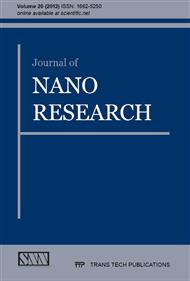[1]
M. A. A. O'Neill, G. J. Vine, A. E. Beezer, A. H. Bishop, J. Hadgraft, C. Labetoulle, M. Walker, P. G. Bowler, Antimicrobial properties of silver-containing wound dressings: a microcalorimetric study, Int. J. Pharm. 263, (2003) 61–68.
DOI: 10.1016/j.ijpharm.2003.11.007
Google Scholar
[2]
N. Durán, P. D. Marcato, G. I. H. D. Souza, O. L. Alves, E. Esposito, Antibacterial Effect of Silver Nanoparticles produced by fungal process on textile fabrics and their effluent treatment, J. Biomed. Nanotech. 3, (2007) 203–208.
DOI: 10.1166/jbn.2007.022
Google Scholar
[3]
S. Y. Yeo, S. H. Jeong, Preparation and characterization of polypropylene/silver nanocomposite fibers, Polymer Int. 52, (2003) 1053–1057.
DOI: 10.1002/pi.1215
Google Scholar
[4]
S. T. Dubas, P. Kumlangdudsana, P. Potiyaraj, Layer-by-layer deposition of antimicrobial silver nanoparticles on textile fibers, Coll. and Surf. A: Phy. Eng. Asp. 289, (200 6) 105–109.
DOI: 10.1016/j.colsurfa.2006.04.012
Google Scholar
[5]
Y. Gao, R. Cranston, Recent Advances in Antimicrobial Treatments of Textiles, Text. R. J. 78, (2008) 60–72.
Google Scholar
[6]
X. Chen, H. J. Schluesener, Nanosilver: a nanoproduct in medical application, Tox. Lett. 176, (2008) 1–12.
Google Scholar
[7]
R. Dastjerdi, M. Montazer, S. Shahsavan, A new method to stabilize nanoparticles on textile surfaces, Coll. and Surf. A: Phy. Eng. Asp. 345, (2009) 202–210.
DOI: 10.1016/j.colsurfa.2009.05.007
Google Scholar
[8]
B. Tomšič, B. Simončič, B. Orel, M. Žerjav, H. Schroers, A. Simončič, Z. Samardžija, Antimicrobial activity of AgCl embedded in a silica matrix on cotton fabric, Carb. Polymers 75, (2009) 618–626.
DOI: 10.1016/j.carbpol.2008.09.013
Google Scholar
[9]
M. -C. Brochier Salon, M. Abdelmouleh, S. Boufi, M. Naceur Belgacem, A. Gandini, Silane adsorption onto cellulose fibers: Hydrolysis and condensation reactions, J. Coll. and Interface Sci. 289, (2005) 249–261.
DOI: 10.1016/j.jcis.2005.03.070
Google Scholar
[10]
C. W. Chu, D. P. Kirby, P. D. Murphy, Interactions of aminosilane with alumina and silica substrates deposited from nonaqueous and aqueous media, J. Adh. and Sci. Technol. 7, (1993) 417–433.
DOI: 10.1163/156856193x00303
Google Scholar
[11]
D. K. Owens, R. C. Wendt, Estimation of the surface free energy of polymers, J. of Appl. Polymer Sci. 13, (1969) 1741–1747.
DOI: 10.1002/app.1969.070130815
Google Scholar
[12]
M. H. El-Rafie, A. A. Mohamed, Th. I. Shaheen, A. Hebeish, Antimicrobial effect of silver nanoparticles produced by fungal process on cotton fabrics, Carb. Polymers 80, (2010) 779–782.
DOI: 10.1016/j.carbpol.2009.12.028
Google Scholar
[13]
M. D. Malinsky, K. L. Kelly, G. C. Schatz, R. P. Van Duyne, Chain length dependence and sensing capabilities of the localized surface plasmon resonance of silver nanoparticles chemically modified with alkanethiol self-assembled monolayers, J. Am. Chem. Soc. 123, (2001).
DOI: 10.1021/ja003312a
Google Scholar
[14]
J. J. Mock, M. Barbic, D. R. Smith, D. A. Schultz, S. Schultz, Shape effects in plasmon resonance of individual colloidal silver nanoparticles, J. Chem. Phys. 116, (2002) 6755– 6759.
DOI: 10.1063/1.1462610
Google Scholar
[15]
S. D. Solomon, M. Bahadory, A. V. Jeyarajasingam, S. A. Rutkowsky, C. Boritz, Synthesis of Silver Nanoparticles, J. Chem. Edu. 84, (2007) 322–325.
DOI: 10.1021/ed084p322
Google Scholar
[16]
M. González Alriols, A. García, R. Llano-ponte, J. Labidi, Combined organosolv and ultrafiltration lignocellulosic biorefinery process, Chem. Eng. J. 157, (2010) 113–120.
DOI: 10.1016/j.cej.2009.10.058
Google Scholar
[17]
E. Nithya, R. Radhai, R. Rajendran, S. Shalini, V. Rajendran, S. Jayakumar, Synergetic effect of DC air plasma and cellulase enzyme treatment on the hydrophility of the cotton fabrics, Carb. Polymers 83, (2011) 1652–1658.
DOI: 10.1016/j.carbpol.2010.10.027
Google Scholar
[18]
N. A. Ibrahim, S. S. Sharaf, M. M. Hashem, A novel approach for low temperature bleaching and carbamoylethylation of cotton cellulose, Car. Polymers 82, (2010) 1248–1255.
DOI: 10.1016/j.carbpol.2010.06.059
Google Scholar
[19]
M. Pantoja, B. Díaz-Benito, F. Velasco, J. Abenojar, J. C. del Real, Analysis of hydrolysis process of γ-methacryloxypropyltrimethoxysilane and its influence on the formation of silane coatings on 6063 aluminum alloy, App. Surf. Sci. 255, (2009).
DOI: 10.1016/j.apsusc.2009.02.022
Google Scholar
[20]
A. Nistal, C. Palencia, M. A. Mazo, F. Rubio, J. Rubio, J. L. Oteo, Analysis of the interaction of vinyl and carbonyl silanes with carbon nanofiber surfaces, Carbon 49, (2011) 1635–1645.
DOI: 10.1016/j.carbon.2010.12.047
Google Scholar
[21]
E. Tang, H. Liu, L. Sun, E. Zheng, G. Cheng, Fabrication of zinc oxide/poly(styrene) grafted nanocomposite latex and its dispersion, Eu. Polymer J. 43, (2007) 4210–4218.
DOI: 10.1016/j.eurpolymj.2007.05.015
Google Scholar
[22]
M. Abdelmouleh, S. Boufi, M. N. Belgacem, A. P. Duarte, A. Ben Salah, A. Gandini, Modification of cellulosic fibres with functionalised silanes: development of surface properties, Int. J. Adh. and Adhesives 24, (2004) 43–54.
DOI: 10.1016/s0143-7496(03)00099-x
Google Scholar
[23]
Y. Xie, C. A. S. Hill, Z. Xiao, H. Militz, C. Mai, Silane coupling agents used for natural fiber/polymer composites: A review, Compos. A: App. Sci. Man. 41, (2010) 806– 819.
DOI: 10.1016/j.compositesa.2010.03.005
Google Scholar
[24]
M. W. Daniels, L. F. Francis, J. Silane Adsorption Behavior, Microstructure and Properties of Glycidoxypropyltrimethoxysilane-Modified Colloidal Silica Coatings, Coll. Interface Sci. 205, (1998) 191–200.
DOI: 10.1006/jcis.1998.5671
Google Scholar
[25]
W. Xing, G. Jie, L. Song, S. Hu, X. Lv, X. Wang, Y. Hu, Flame retardancy and thermal degradation of cotton textiles based on UV-curable flame retardant coatings, Th. Acta 513, (2011) 75–82.
DOI: 10.1016/j.tca.2010.11.014
Google Scholar
[26]
M. Abboud, M. Turner, E. Duguet, M. Fontanille, PMMA-based composite materials with reactive ceramic fillers, J. Mater. Chem. 7, (1997) 1527–1532.
DOI: 10.1039/a700573c
Google Scholar
[27]
M. Garcia-Heras, A. Jimenez-Morales, B. Casal, J. C. Galvan, S. Radzki, M. A. Villegas, Preparation and electrochemical study of cerium–silica sol–gel thin films, J. Alloys and Comp. 380, (2004) 219–224.
DOI: 10.1016/j.jallcom.2004.03.047
Google Scholar
[28]
B. Liu, S. Cao, X. Deng, S. Li, R. Luo, Adsorption behavior of protein onto siloxane microspheres, App. Surf. Sci. 252, (2006) 7830–7836.
DOI: 10.1016/j.apsusc.2005.09.058
Google Scholar


